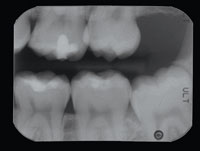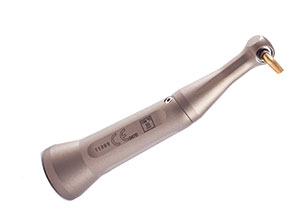There have never been more treatment options for dental patients than there are today. With all the choices that dentists and patients have, there are sometimes simple treatments that can be overlooked. There has been much discussion in the orthodontic literature regarding the practice of upper and/or lower second molar extraction, followed by third molar replacement.1-5 However, the idea of third molar replacement of extracted second molars is often overlooked as a restorative option.
When a permanent second molar is grossly carious and painful, there are typically 2 treatment options. One option is saving the tooth with root canal therapy, buildup, and crown. The other option is extraction. Although saving the tooth is usually the most conservative choice, the procedures to do so are relatively complicated, costly, and can sometimes necessitate possible future treatment as well. On the other hand, the more radical choice of extracting the tooth is relatively simple and inexpensive. This case report shows an actual example of how a more radical treatment can actually be a realistic and conservative option for the patient.
CASE REPORT
 |
 |
|
Figure 1. A 16-year-old patient presented in pain from a grossly carious tooth No. 15 (January 2007). |
Figure 2. A “radical” treatment plan recommending extraction of No. 15 (instead of salvaging the tooth with root canal therapy, a core, and crown) was presented and accepted as the “conservative” choice. |
 |
 |
|
Figures 3. Fourteen months later (April 2008), tooth No. 16 erupted into the space once occupied by tooth No. 15. |
Figure 4. Tooth No. 16 moved into excellent occlusion and function (April 2008). |
A 16-year-old Hispanic male, with no medical contraindications, came into our office in January 2007 for a comprehensive oral exam and a full series of periapical and bitewing radiographs. The upper left permanent second molar (tooth No. 15) was grossly carious and painful with the caries extending into the pulp (Figures 1 and 2).
We determined that there were 2 treatment choices for this tooth: it could be saved with root canal therapy and restorative treatment including a core and crown; or it could be extracted. There are pros and cons to either treatment option. Root canal therapy is typically more time-consuming, more complicated, and more costly than extraction, which is usually quick, simple, and relatively inexpensive. Another consideration is that after the root canal therapy and all the restorative procedures are done, the tooth may even require additional treatments in the future. Still, in most situations other than cost, it is certainly preferable to save a permanent tooth rather than remove it. Since tooth No. 16 was unerupted and appeared that it would most likely erupt and move into the position of tooth No. 15, extraction of tooth No. 15 was presented as a possible treatment option to the patient’s mother and the patient.
It was explained to the patient and his mother that although no guarantee could be made, if tooth No. 15 were removed, there was a good probability that tooth No. 16 would erupt into the former space occupied by tooth No. 15. They were informed that this would occur sometime soon after the extraction was performed. Although root canal therapy, core, and crown are usually excellent options, these treatments sometimes fail, resulting in work that may need to be redone and/or revised. Furthermore, sometimes extensively treated teeth require removal in the future. A virgin tooth, in proper position and without pathology, would almost always be preferable to a tooth that has had extensive or complicated treatment.
After discussion of the various options, the patient’s mother, the patient, and the treating dentist were in agreement that extraction of tooth No. 15 would be the best treatment in this situation. Tooth No. 15 was anesthetized and extracted without complications at the same visit in January 2007. The next time the patient came to the office was 14 months later in April 2008. Tooth No. 16, a virgin tooth, which was confirmed to be present and unerupted in the radiograghs prior to extraction of tooth No. 15, had erupted into tooth No. 15’s former position and now provided the patient with excellent occlusion and function (Figures 3 and 4).
CONCLUSION
In this case, a simple, relatively inexpensive and radical treatment (extraction) yielded a conservative result with the virgin tooth erupting in to replace the extracted tooth. This effectively demonstrates that the least desirable treatment in one case can be the ideal treatment in another case. In patients under 30 years old, when a second molar requires root canal therapy, and there is an unerupted third molar that appears it will erupt normally into the second molar position, extraction of the second molar should be seriously considered as a treatment option.
References
- Cavanaugh JJ. Third molar changes following second molar extractions. Angle Orthod. 1985;55:70-76.
- Asai M, Tomochika A, Asai Y. Molar extraction: a perspective on a clinical study. Orthodontic Waves. 2007;66:41-51.
- Dacre JT. The criteria for lower second molar extraction. Br J Orthod. 1987;14:1-9.
- Orton-Gibbs S, Crow V, Orton HS. Eruption of third permanent molars after the extraction of second permanent molars. Part 1: assessment of third molar position and size. Am J Orthod Dentofacial Orthop. 2001;119:226-238.
- De-la-Rosa-Gay C, Valmaseda-Castellón E, Gay-Escoda C. Spontaneous third-molar eruption after second-molar extraction in orthodontic patients. Am J Orthod Dentofacial Orthop. 2006;129:337-344.
Dr. Michael Wahl serves on the faculties of Temple University School of Dental Medicine and Christiana Care Health Services. The creator of the presentation and home study courses “Medical Myths of Clinical Dentistry” and “The Lazy Dentist’s Guide to Excellence,” he is in full-time private general practice in Wilmington, Del. His latest book and audiotape system is The Lazy Dentist in the New Millennium. He has lectured internationally at many major dental meetings, including the ADA Annual Meeting, the California Dental Association Spring Scientific Session, the Greater New York Dental Meeting, the Yankee Dental Congress, and the Excellence in Dentistry Spring Break Seminar in Destin, Fla. His numerous publications include many major medical and dental journals. He can be reached at (302) 655-1228 or wahlmichaelj@aol.com.
Dr. Jean Wahl is in private general practice in Wilmington, Del, and has published articles in national dental journals. She can be reached at (302) 655-1228 or jean@officemagic.com.











